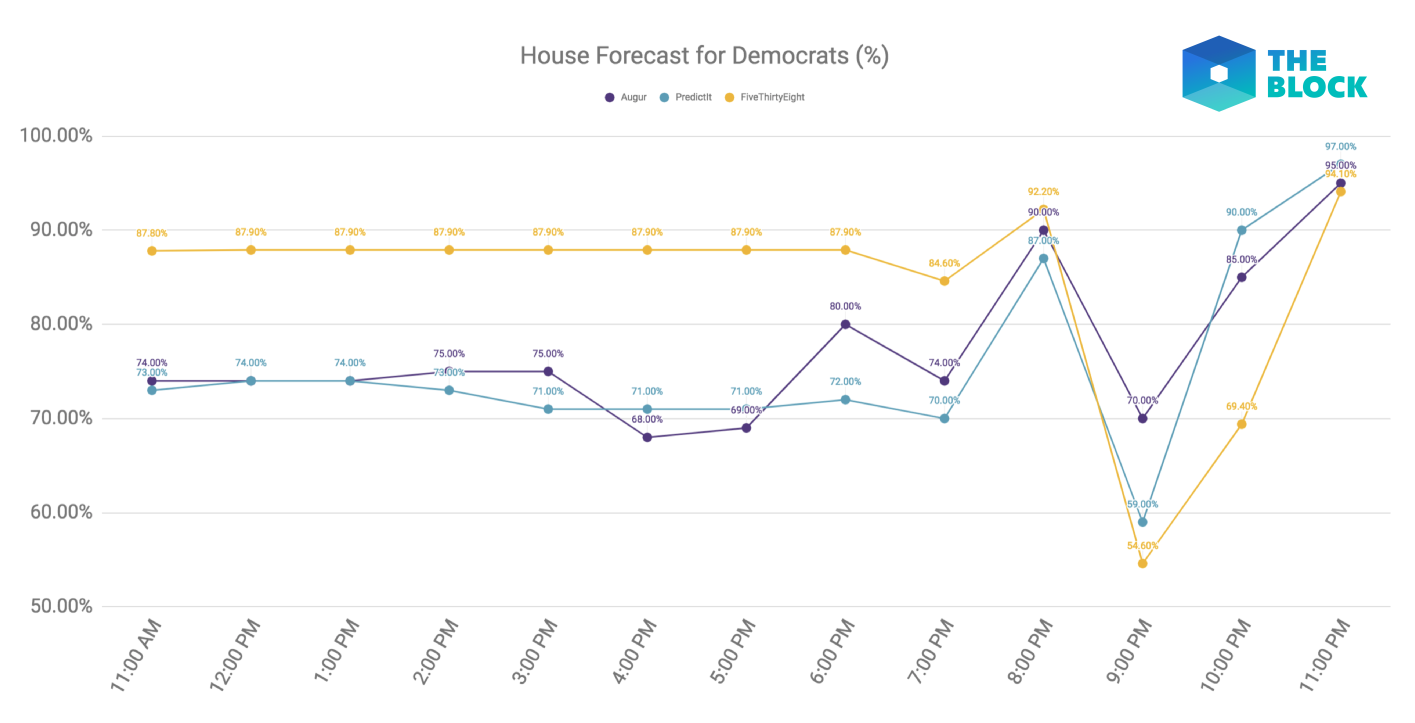Results: Auguring the 2018 U.S. Midterm Elections

Quick Take
- It appears that last night, prediction markets were essentially tracking the poll results of FiveThirtyEight
- The House forecast market on Augur was a relative success — $1.6M in ether was placed on the market by ~360 participants.
- The Senate forecast market was abysmal receiving only $24K in ether volume, placed by five participants.

Before we get started: Our Augur experiment is just that -- an experiment. As such, the conclusions here are based on observations from our small sample size. So please do take them with a grain of salt.
Last night The Block ran an experiment comparing the prediction markets results of PredictIt and Augur alongside the opinion poll analyses of FiveThirtyEight during the 2018 U.S. Midterm Elections. We updated the results on an hourly basis from 11 a.m. to 11 p.m. EST. The following is what we observed.
Smart money might not be so smart
FiveThirtyEight, one of the most popular poll-analytics sites, did not release election results until 6 p.m. EST when the first polling places began to close. Prior to FiveThirtyEight’s updated models with actual results, forecasts on Augur and PredictIt for U.S. House control were relatively flat — reflecting the consensus of the Democrats taking control. However, after FiveThirtyEight started reporting polling results, both Augur and PredictIt became widely volatile — appearing to track FiveThirtyEight’s data in real-time.
As an example, at 9 p.m., FiveThirtyEight drastically decreased the chances of Democrats winning the House and the prediction markets on Augur and PredictIt quickly followed suit. The trend where FiveThirtyEight acted as a leading indicator continued until the end of our experiment. While prediction markets are supposed to leverage the power of “wisdom of the crowd” to make highly accurate predictions, it appears that yesterday night, the smart money was tracking the poll results of one website.

Augur still lacks liquidity
The House forecast market on Augur was a relative success — $1.6M in ether was placed by approximately 360 participants. However, the Senate forecast market was abysmal, with only $24K in ether volume, placed by just five participants. This explains why the Augur Senate market gave the Republicans an 88% chance of taking the Senate at 11 p.m., while PredictIt and FiveThirtyEight gave the Republicans 99% and 100%, respectively. A lack of liquidity/interest explains why estimates on Augur were flat from 8 p.m. to 11 p.m., even as the estimates of a Republican victory continue to increase throughout the night.

Conclusion
We were able to see the use case of Augur in action last night. Users were able to bet over $1 million on the results of a major event. However, while the House forecast might be considered a minor success given the newness of the Augur platform, there's still a long way to go. Compare the hundreds of Augur users against PredictIt, which had more than 900,000 participants in their House market and more than 180,000 participants betting on the Senate.
[related id="1"]
© 2023 The Block. All Rights Reserved. This article is provided for informational purposes only. It is not offered or intended to be used as legal, tax, investment, financial, or other advice.



